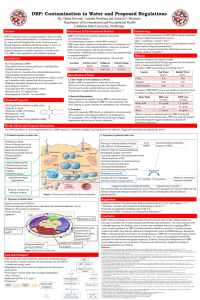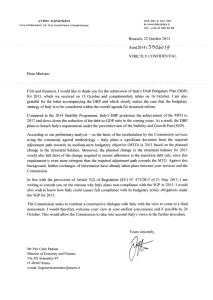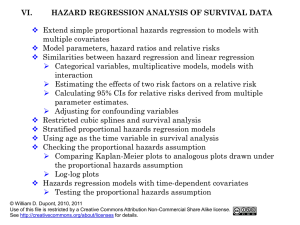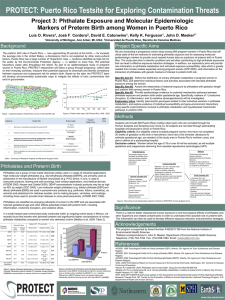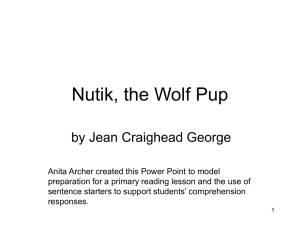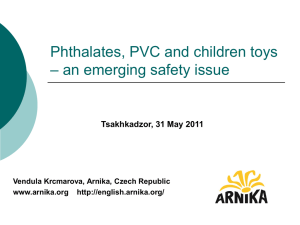Di-n-butyl Phthalates (DBP)
advertisement
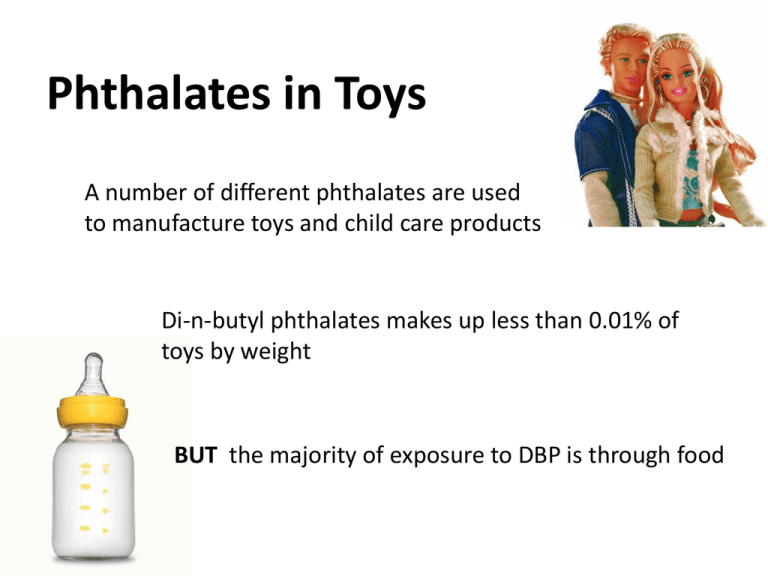
Phthalates in Toys A number of different phthalates are used to manufacture toys and child care products Di-n-butyl phthalates makes up less than 0.01% of toys by weight BUT the majority of exposure to DBP is through food Risk Assessment: Di-n-butyl Phthalates (DBP) in Food By: Lani Gabriel And Chantel Yanagwa Physical Properties Di-n-butyl Phthalate (DBP) • Soluble in: 1. Ether 2. Benzene 3. Organic Compounds 4. Water (Slightly) • Colorless to yellow oily liquid Common Uses for DBP • DBP is a PLASTICIZER that is commonly used as a (n): 1. additive for adhesives 2. softener to impart flexibility to rigid plastic products 3. solvent for oil soluble dyes, insecticides, peroxides & organic compounds 4. antifoaming agent and fiber lubricant in the textile industry Products Containing DBP Lotions & Suntan Lotions • increases absorption Nail polish • prevents chipping Products Containing DBP (cont.) Food Storage Containers • increases flexibility Adhesives • increases its ability to adhere Products Containing DBP (cont.) School Supplies • increases flexibility in erasers Prescription Drugs • Used for compounding • Controls release Environmental Persistence • Does not readily break down in water or deep within the soil • Breaks down in the presence of air and sunlight – Half life of 1.8 days • Does not bioaccumulate in the environment, but has the potential to Hazard Identification Many Studies Indicate: • endocrine disruption Some Studies Indicate: • Carcinogenic Population at Risk Route of Exposure • Ingestion – Anything containing DBP that can be put into the mouth • Inhalation • Dermal and Eye contact V. Salazar et al. • Three study groups 1. Control 2. DBP 0.61g/kg soy free rat chow 3. DBP 2.5g/kg soy free rat chow • Male pups were assessed for weight loss: – Total Body Weight – Thymus – Testis V. Salazar et al. (cont.) Weight Loss Findings of Body Weight And Thymus Description Control DBP 0.61 DBP 2.5 Male pups weight (g) 24.3 ± 0.5 23.2 ± 0.7 24.8 ± 0.5 Male pups thymus relative weight (mg/g) 4.09 ± 0.39 4.13 ± 0.32 3.69 ± 0.06 Measurements were taken 14 days after birth No significant differences observed in total body weight and weight of thymus V. Salazar et al. (cont.) Testis Relative Weight for Male Pups Notable weight loss observed in male testis for both experimental groups compared to control V. Salazar et al. (cont.) • Pubertal Parameters were Studied in Pups Males Anogenital Separation Females Vaginal Opening R. Kavlock et al. • Survey conducted on general population exposure to DBP was estimated by: 1. 2. 3. 4. International Program on Chemical Safety (IPCS) UK Ministry of Agriculture Fisheries and Food (MAFF) Health Canada US Agency and Toxic Substance and Disease Registry (ATSDR) • Reproductive toxicity of DBP was reported by Wine et al. R. Kavlock et al. • Reproductive toxicity was assessed in: Males: 1. 2. 3. 4. Control DBP 52 mg/kg/day DBP 256 mg/kg/day DBP 509 mg/kg/day Females: 1. 2. 3. 4. Control DBP 80 mg/kg/day DBP 385 mg/kg/day DBP 794 mg/kg/day R. Kavlock et al. DBP Reproductive Toxicity in Rats Male Dose (mg/kg/day) Female Dose (mg/kg/day) 0 0 N/A 52 80 ↓ Live pups/litter 256 385 ↓ Live pups/litter ↓ pup weight 794 ↓ Live pups/litter ↓ pup weight ↑ Liver and Kidney to body weight ratio ↓ pup weight from females in crossover 209 Effects R. Kavlock et al. Health Canada DBP Exposure Estimates for 6 months to 4 Years of Age Medium Estimated Intake (mg/kg/day) Ambient air 4.0 x 10-7 Indoor air 9.1 x 10-4 Drinking Water 6.2 x 10-5 Food 4.1 x 10-3 Soil 5.4 x 10-6 Total Estimated Intake 5.0 x 10-3 Uncertainty Factors Score Human Variability 10 Age difference? Diet? Ethnicity? Geographic location? 10 Studies were conducted in rodents. Is this applicable to humans? Acute to Chronic Extrapolations 5 Studies were based on acute exposures. Chronic exposures? Database Uncertainty 3 Were there any uncertainty factors accounted for? Children 10 No studies found on children Total 38/50 High Level of Uncertainty Interspecies Extrapolation Comments Dose Response LOAEL • per Wine et al. = 250 mg/kg/day • US EPA = 600mg/kg/day NOAEL • per Wine et al. = 50 mg/kg/day • US EPA = 125 mg/kg/day Dose Response • Uncertainty Factor = 10 x 10 x 5 x 3 x 10 = 15,000 • Rfd = Wine et al. NOAEL/Uncertainty Factors = 50/15,000 = 0.0033 mg/kg/day • US EPA Rfd = 0.1 mg/kg/day Precautionary Assessment: COMMUNITY / SOCIAL ISSUES Parameter Score Comment Goal 1 Rfd was calculated much lower than the NOAEL listed for human intake by US EPA Need 1 Greatest exposure occurs through food with an increased exposure through other consumer products Future Generations 3 Reproductive and developmental problems have been observe in animal studies Democratic, Community Based Process 3 Community is not well informed of DBP and little involvement Alternatives 3 Alternatives were not considered or found during our research, but possible alternatives maybe available Total 11/15 Poor support for health and community Precautionary Assessment: EXPOSURE ISSUES Parameter Score Comment Exposure 0 No control over exposure because of cultivating , processing , and packaging material Multiple exposures 3 Presence of multiple phthalates i.e. DEHP, BBP, DINP, DIDP, & DnOP Children exposed 5 Children are more vulnerable because they are still developing mentally and physically Consumer products 3 DBP is present in multiple consumer products Occupational exposure 0 Focused on ingestion of DBP in children Food exposure 3 Food is estimated to be the greatest source of DBP exposure Total 14/20 Significant level of exposure Precautionary Assessment: HAZARD / TOXICITY Parameter Score Comment Hazard 7 Reproductive toxicity was observed in animal studies Individual Sensitivity 2 Infants are more susceptible than 4 year olds Ecological hazard 3 Found in the environment Volume 5 >100,000 lbs/year (only found value for Europe) Persistent 2 Protection in the environment through deep soils and ground water Bioaccumulate 2 May have the potential to bioaccumulate, but was found in high concentrations in fish Uncertainty 3 Applicability of animal studies for humans? Synergistic effects? Long term effects? Total 24/30 High concern and many unknowns Current Regulations • US Consumer Product Safety Improvement Act 2008 » Permanently Banded: 1. diethylhexyl phthalate (DEHP) 2. dibutyl phthalate (DBP) 3. butylbenzyl phthalate (BBP) » Temporarly Banded: 1. di-isononyl phthalate (DINP) 2. di-isodecyl phthalate (DIDP) 3. di-n-octyl phthalate (DnOP) Current Regulations (cont.) • California bands all 6 phthalates under Assembly Bill 1108 • European Union under Directive 2005/84/EC ONLY bands 3 phthalates: 1. diethylhexyl phthalate (DEHP) 2. dibutyl phthalate (DBP) 3. butylbenzyl phthalate (BBP) • Canada proposes band in 2009 similar to US (NO update since) Current Regulations (cont.) • All regulations previously discussed ONLY address consumer products in which children are exposed to • In the US there is currently NO regulations in place for food and cosmetic products Recommendations • Provide education to community on: – – – Presence of DBP and other phthalates How food is cultivated and packaged How to shop for DBP free alternative products • Added pressures on manufacturing industries and farming community – Encourage decrease of DBP use – Encourage using DBP free alternatives – Provide educational background on environmental & community effects Recommendations (cont.) • Additional studies on: – – – Concentrations similar to those estimated for our population at risk Larger sample sizes Synergistic effects • With additional studies the possibility of new regulations can be put into place References Please visit Toxipedia for our list of references Image provided by Steve Gilbert http://www.toxipedia.org/display/toxipedia/ENV+H+472-572+A+-+Environmental+Risk http://www.greencape.org/endocrine.html


![Booking Form SPaRC ASM 27 March 2014[1].ppt](http://s2.studylib.net/store/data/005467834_1-e4871078a04d228fe869fa8fba421428-300x300.png)

